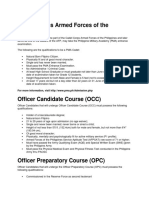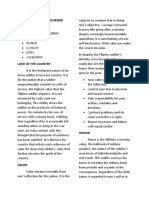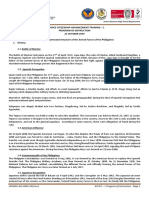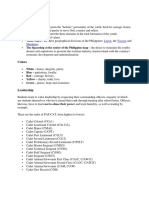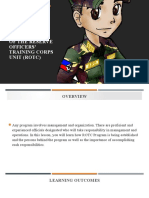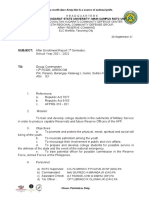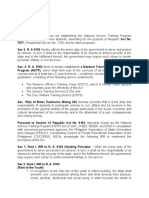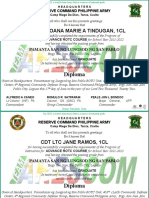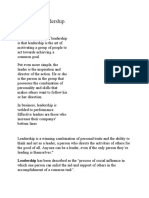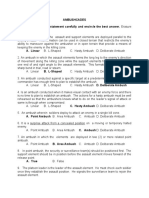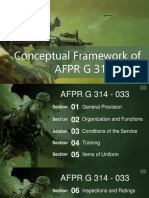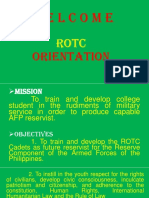0 ratings0% found this document useful (0 votes)
105 viewsC.A.T and P.M.T
Uploaded by
coordinates1028Copyright
© © All Rights Reserved
We take content rights seriously. If you suspect this is your content, claim it here.
Available Formats
Download as DOCX, PDF, TXT or read online on Scribd
0 ratings0% found this document useful (0 votes)
105 viewsC.A.T and P.M.T
Uploaded by
coordinates1028Copyright
© © All Rights Reserved
We take content rights seriously. If you suspect this is your content, claim it here.
Available Formats
Download as DOCX, PDF, TXT or read online on Scribd
You are on page 1/ 1
OVERVIEW OF CITIZEN ADVANCEMENT essential values while adapting to modern
TRAINING (C.A.T.) educational standards and societal needs.
Citizenship Advancement Training (C.A.T.) is a OVERVIEW OF PHILIPPINE MILITARY
mandatory educational program in the TRAINING (P.M.T)
Philippines for fourth-year high school students Philippine Military Training (PMT) is a military
in both public and private schools. It education program that was previously
emphasizes the value of civic awareness and mandatory for students in junior and senior
responsibility, aiming to develop students into high school in the Philippines. The training is
productive citizens who can contribute to the designed to instill discipline, patriotism, and a
nation's welfare. sense of duty among the youth, preparing
them for potential service in national defense.
Program Components
The C.A.T. program includes various Historical Context
components such as military orientation, PMT originated as Preparatory Military Training.
community service, and public safety training. It shares a historical connection with the
Educational guidelines ensure that schools Reserve Officers' Training Corps (ROTC), which
determine the specific elements of C.A.T. to be has evolved over the years, reflecting changes
offered, focusing on instilling a sense of in the country's military and educational
nationalism and civic duty among students. policies. The training was formalized under
various legislative acts, including the National
Historical Context Defense Act of 1935, which made ROTC
Originally known as "Citizen Army Training," compulsory in higher education institutions.
the program has evolved significantly since its
inception in 1935, when it was mandated by Structure and Implementation
the National Defense Act. The transition from a The structure of PMT involves various levels of
purely militaristic program to one that training that provide military education,
incorporates community service reflects including physical conditioning, leadership
broader societal changes regarding national training, and civic education. While initially
service and education. mandatory, the program has undergone
transformations, including shifts to voluntary
Learning Outcomes participation with the implementation of the
C.A.T. aims to promote values such as National Service Training Program (NSTP) in
patriotism, discipline, and leadership among 2002, which allowed students to choose
students. Through various activities, including between ROTC and other service programs.
community service projects and drills, students
are encouraged to develop responsibilities that Transition and Current Status
extend beyond the classroom, leading to As of 2002, ROTC became an optional
personal growth and community engagement. component of the NSTP, leading to a significant
decrease in enrollment from over 800,000
Current Implementation students in the 1999-2000 school year to about
Currently, C.A.T. operates under the K-12 150,000 by the 2011-2012 school year. There
curriculum framework, maintaining its has been ongoing debate regarding the
relevance amid educational reforms. The potential reinstatement of mandatory ROTC or
program continues to provide valuable similar military training programs, reflecting a
experiences to students, emphasizing societal interest in promoting discipline among
volunteerism and civic duty, while ensuring Filipino youth.
that any military orientation is conducted
within the stipulated guidelines to avoid
compulsory drills and ceremonies.
Conclusion
In summary, C.A.T. in the Philippines serves as
a crucial educational framework aimed at
fostering responsible citizenship among the
youth. Through its implementation, it promotes
You might also like
- Planning: Speech: Levelt's Model of L1 ProductionNo ratings yetPlanning: Speech: Levelt's Model of L1 Production22 pages
- Afp History: Headquarters Army Reserve Command Camp Riego de Dios, Tanza, Cavite50% (2)Afp History: Headquarters Army Reserve Command Camp Riego de Dios, Tanza, Cavite33 pages
- Military-Science-1 Midterm Reviewer FullNo ratings yetMilitary-Science-1 Midterm Reviewer Full58 pages
- NSTP 1 25 CM CWTS Course Syllabus For AY 2024 2025No ratings yetNSTP 1 25 CM CWTS Course Syllabus For AY 2024 202516 pages
- 406 (Orm) Community Defense Center, 4Rcdg, Arescom Department of Military Science and Tactics Labasan, Bongabong, Oriental Mindoro100% (1)406 (Orm) Community Defense Center, 4Rcdg, Arescom Department of Military Science and Tactics Labasan, Bongabong, Oriental Mindoro6 pages
- Republic Act No. 7077 - Official Gazette of The Republic of The Philippines0% (1)Republic Act No. 7077 - Official Gazette of The Republic of The Philippines22 pages
- C O R E V A L U E S: Afp Code of Ethics (April 2006)No ratings yetC O R E V A L U E S: Afp Code of Ethics (April 2006)88 pages
- Lesson 1. Physical Organization of The Reserve Officers TrainingNo ratings yetLesson 1. Physical Organization of The Reserve Officers Training33 pages
- After Enrollment Narrative Report 1st Sem SY 2021-2022No ratings yetAfter Enrollment Narrative Report 1st Sem SY 2021-20223 pages
- Philippine Army Journal 1st Quarter 2013No ratings yetPhilippine Army Journal 1st Quarter 201372 pages
- Concept of Leadership.: Leadership Has Been Described As The "Process of Social Influence inNo ratings yetConcept of Leadership.: Leadership Has Been Described As The "Process of Social Influence in5 pages
- Annex Iii. Applicant Personal History Statement FormNo ratings yetAnnex Iii. Applicant Personal History Statement Form7 pages
- After Activity Report Wreath Laying CeremonyNo ratings yetAfter Activity Report Wreath Laying Ceremony7 pages
- The Perception On Rotc Implementation Among Students of City University of PasayNo ratings yetThe Perception On Rotc Implementation Among Students of City University of Pasay12 pages
- Fivush R Haden C A and Reese E 2006 ElabNo ratings yetFivush R Haden C A and Reese E 2006 Elab21 pages
- Authenticity in the Psychoanalytic Encounter The Work of Irma Brenman Pick 1st Edition Irma Brenman Pick - The ebook is ready for download, no waiting required100% (1)Authenticity in the Psychoanalytic Encounter The Work of Irma Brenman Pick 1st Edition Irma Brenman Pick - The ebook is ready for download, no waiting required64 pages
- 7 Storytelling Techniques From Inspiring TED PresentersNo ratings yet7 Storytelling Techniques From Inspiring TED Presenters10 pages
- CSE PROGRAM_BOOK_FOR_COMMUNITY_SERVICE_PROJECT_-R23No ratings yetCSE PROGRAM_BOOK_FOR_COMMUNITY_SERVICE_PROJECT_-R2343 pages
- Noisy Bird Fact Sheet and Communication LetterNo ratings yetNoisy Bird Fact Sheet and Communication Letter4 pages
- Download Complete Machines like me And People like you First Edition Ian Mcewan PDF for All Chapters100% (2)Download Complete Machines like me And People like you First Edition Ian Mcewan PDF for All Chapters50 pages
- An Existentialist Analysis of Orwell S 1984 Thomas Gatzwiller PDFNo ratings yetAn Existentialist Analysis of Orwell S 1984 Thomas Gatzwiller PDF21 pages
- (Ebook PDF) Educational Psychology Between Certitudes and Uncertainties 1st edition by Victorița Trif 1789845270 978-1789845273 full chapters - Download the ebook today to explore every detail100% (6)(Ebook PDF) Educational Psychology Between Certitudes and Uncertainties 1st edition by Victorița Trif 1789845270 978-1789845273 full chapters - Download the ebook today to explore every detail87 pages
- MATH Q1 WEEK 4 DAY 3 Multiplying Mentally 2-Digit by 2-Digit Numbers ... MarvietblancoNo ratings yetMATH Q1 WEEK 4 DAY 3 Multiplying Mentally 2-Digit by 2-Digit Numbers ... Marvietblanco18 pages
- Deep Brain Stimulation of The Substantia Nigra Pars Reticulata For Treatment-Resistant Schizophrenia: A Case ReportNo ratings yetDeep Brain Stimulation of The Substantia Nigra Pars Reticulata For Treatment-Resistant Schizophrenia: A Case Report3 pages
- Mental Models: An Interdisciplinary Synthesis of Theory and MethodsNo ratings yetMental Models: An Interdisciplinary Synthesis of Theory and Methods13 pages
- Advantages and Disadvantages of Job AnalysisNo ratings yetAdvantages and Disadvantages of Job Analysis8 pages
- Examination of The Author's Argument and Point of View100% (1)Examination of The Author's Argument and Point of View23 pages
- Full Download Our Sexuality 13th Edition Robert L. Crooks PDF DOCX50% (2)Full Download Our Sexuality 13th Edition Robert L. Crooks PDF DOCX55 pages
- MAN Mcqs 22509 Management MCQs MSBTE Exam MCQs - MSBTE All Clear Msbte Solution All Diploma Study MaterialNo ratings yetMAN Mcqs 22509 Management MCQs MSBTE Exam MCQs - MSBTE All Clear Msbte Solution All Diploma Study Material16 pages
- (WWW - Asianovel.com) - The Good For Nothing Seventh Young Lady 0001-0050No ratings yet(WWW - Asianovel.com) - The Good For Nothing Seventh Young Lady 0001-0050179 pages






